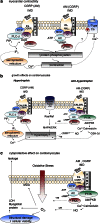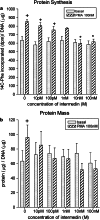Intermedin (adrenomedullin-2): a novel counter-regulatory peptide in the cardiovascular and renal systems
- PMID: 17965749
- PMCID: PMC2268039
- DOI: 10.1038/sj.bjp.0707494
Intermedin (adrenomedullin-2): a novel counter-regulatory peptide in the cardiovascular and renal systems
Abstract
Intermedin (IMD) is a novel peptide related to calcitonin gene-related peptide (CGRP) and adrenomedullin (AM). Proteolytic processing of a larger precursor yields a series of biologically active C-terminal fragments, IMD(1-53), IMD(1-47) and IMD(8-47). IMD shares a family of receptors with AM and CGRP composed of a calcitonin-receptor like receptor (CALCRL) associated with one of three receptor activity modifying proteins (RAMP). Compared to CGRP, IMD is less potent at CGRP(1) receptors but more potent at AM(1) receptors and AM(2) receptors; compared to AM, IMD is more potent at CGRP(1) receptors but less potent at AM(1) and AM(2) receptors. The cellular and tissue distribution of IMD overlaps in some aspects with that of CGRP and AM but is distinct from both. IMD is present in neonatal but absent or expressed sparsely, in adult heart and vasculature and present at low levels in plasma. The prominent localization of IMD in hypothalamus and pituitary and in kidney is consistent with a physiological role in the central and peripheral regulation of the circulation and water-electrolyte homeostasis. IMD is a potent systemic and pulmonary vasodilator, influences regional blood flow and augments cardiac contractility. IMD protects myocardium from the deleterious effects of oxidative stress associated with ischaemia-reperfusion injury and exerts an anti-growth effect directly on cardiomyocytes to oppose the influence of hypertrophic stimuli. The robust increase in expression of the peptide in hypertrophied and ischaemic myocardium indicates an important protective role for IMD as an endogenous counter-regulatory peptide in the heart.
Figures







Similar articles
-
Protective effects of intermedin on cardiovascular, pulmonary and renal diseases: comparison with adrenomedullin and CGRP.Curr Protein Pept Sci. 2013 Jun;14(4):294-329. doi: 10.2174/13892037113149990049. Curr Protein Pept Sci. 2013. PMID: 23745696 Review.
-
Intermedin/adrenomedullin-2 acts within central nervous system to elevate blood pressure and inhibit food and water intake.Am J Physiol Regul Integr Comp Physiol. 2005 Apr;288(4):R919-27. doi: 10.1152/ajpregu.00744.2004. Epub 2004 Dec 2. Am J Physiol Regul Integr Comp Physiol. 2005. PMID: 15576658
-
Intermedin/adrenomedullin2: an autocrine/paracrine factor in vascular homeostasis and disease.Sci China Life Sci. 2014 Aug;57(8):781-9. doi: 10.1007/s11427-014-4701-7. Epub 2014 Aug 8. Sci China Life Sci. 2014. PMID: 25104450 Review.
-
Adrenomedullin 2/intermedin in the hypothalamo-pituitary-adrenal axis.J Mol Neurosci. 2011 Feb;43(2):182-92. doi: 10.1007/s12031-010-9413-2. Epub 2010 Jul 2. J Mol Neurosci. 2011. PMID: 20596793 Review.
-
Structure-function analyses reveal a triple β-turn receptor-bound conformation of adrenomedullin 2/intermedin and enable peptide antagonist design.J Biol Chem. 2018 Oct 12;293(41):15840-15854. doi: 10.1074/jbc.RA118.005062. Epub 2018 Aug 23. J Biol Chem. 2018. PMID: 30139742 Free PMC article.
Cited by
-
Intermedin Alleviates Vascular Calcification in CKD through Sirtuin 3-Mediated Inhibition of Mitochondrial Oxidative Stress.Pharmaceuticals (Basel). 2022 Oct 2;15(10):1224. doi: 10.3390/ph15101224. Pharmaceuticals (Basel). 2022. PMID: 36297336 Free PMC article.
-
A crucial role of endoplasmic reticulum stress in cellular responses during pulmonary arterial hypertension.Am J Transl Res. 2020 May 15;12(5):1481-1490. eCollection 2020. Am J Transl Res. 2020. PMID: 32509157 Free PMC article. Review.
-
Intermedin suppresses pressure overload cardiac hypertrophy through activation of autophagy.PLoS One. 2013 May 29;8(5):e64757. doi: 10.1371/journal.pone.0064757. Print 2013. PLoS One. 2013. PMID: 23737997 Free PMC article.
-
Intermedin is overexpressed in hepatocellular carcinoma and regulates cell proliferation and survival.Cancer Sci. 2012 Aug;103(8):1474-80. doi: 10.1111/j.1349-7006.2012.02341.x. Epub 2012 Jul 11. Cancer Sci. 2012. PMID: 22625651 Free PMC article.
-
Protective effect of intermedin on myocardial cell in a rat model of severe acute pancreatitis.Cell Mol Biol Lett. 2011 Sep;16(3):462-76. doi: 10.2478/s11658-011-0020-1. Epub 2011 Jul 18. Cell Mol Biol Lett. 2011. PMID: 21786034 Free PMC article.
References
-
- Abdelrahman AM, Pang CCY. Effect of intermedin/adrenomedullin-2 on venous tone in conscious rats. Naunyn Schmied Arch Pharmacol. 2006;373:376–380. - PubMed
-
- Alevizaki M, Shiraishi A, Rassool FV, Ferrier GJM, Macintyre I, Legon S. The calcitonin-like sequence if the β-CGRP gene. FEBS Lett. 1986;206:47–52. - PubMed
-
- Autelitano DJ, Ridings R. Adrenomedullin signalling in cardiomyocytes is dependent upon CRLR and RAMP2 expression. Peptides. 2001;22:1851–1857. - PubMed
-
- Bell D, McDermott BJ. CGRP stimulates a positive contractile response in rat ventricular cardiomyocytes. J Cardiovasc Pharmacol. 1994;23:1011–1021. - PubMed
-
- Bell D, McDermott BJ. Calcitonin gene-related peptide in the cardiovascular system: characterisation of receptor populations and their pathophysiological significance. Pharmacol Rev. 1996;48:253–288. - PubMed
Publication types
MeSH terms
Substances
LinkOut - more resources
Full Text Sources
Other Literature Sources
Molecular Biology Databases
Research Materials

